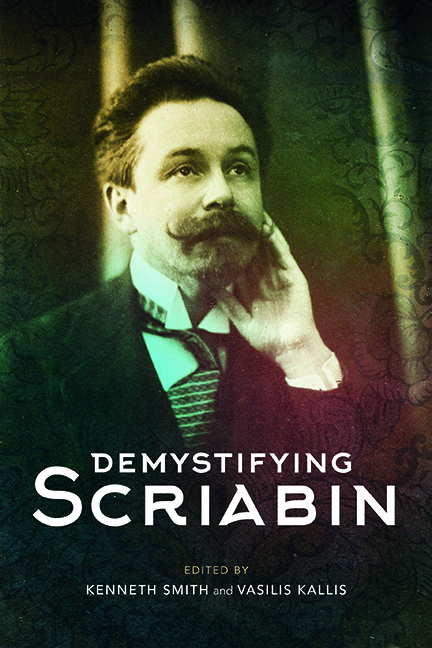7 - The Scriabin Tremor and Its Role in HisOeuvre
Published online by Cambridge University Press: 07 October 2022
Summary
For the past few decades, primarily in Westernscholarship, there has been great interest inset-theoretical approaches and referentialcollections in Alexander Scriabin's music. However,most of these writings have examined Scriabin's lateharmonic language in isolation from his earliercompositional practice. I take the lens ofDisability Studies in music to expand on a peculiartwo-note motive, reminiscent of a sigh motive, thatis prevalent in Scriabin's middle and late works.Although I approach my analysis from a hermeneuticangle, the notion of a disabled body figures quitephysically into Scriabin's own life because heinjured his right hand practicing Liszt's Don Juan fantasy. Duringthis period (1891–4), Scriabin worked very hard toovercompensate for his lost sense of virtuosity as atemporarily disabled pianist and, consequently, heturned his attention more to composing. This notionof overcoming became particularly important in hislife, as he turned more to composition to compensatefor his disabled right hand. Further, theuncertainty of whether he was ever going to performagain with both hands made its way into thecompositions that followed his injury. The sighmotive, which can be traced to the Baroque period,is significant in Scriabin's works, as it can beattributed to Scriabin's own lament over histemporarily lost virtuosic abilities as a pianist.As I will show, in Scriabin's works, there are ahandful of works that become driven by the sighmotive and then evolve to a more pronouncedsemitonal oscillation between two notes – which Icall the Scriabin ‘tremor’. This latter, elongatedversion of the sigh persists throughout hiscompositional oeuvre, even into his late works.Thus, the Scriabin tremor takes on a prominentmotivic role in his middle and even late works,disturbing the musical body out of its balance.
In describing disability in relation to music, JosephStraus writes, ‘The normative and desirable bodilystate (balance and rest) is understood in relationto a non-normative and undesirable state (imbalanceand unrest)’. Further, disability is described as adeviation from the norm – the stigmatised body. As Iwill show, this aspect of disability studies –namely, the stigmatised body – is crucial inunderstanding the Scriabin tremor, as Scriabin's ownphysical hand injury at the Moscow Conservatoiretraverses from the physical world to his musicalcompositions. Further, Disability Studies serves asa lens to discuss Scriabin's middle-period works,which embody aspects of disability often expressedas a descending two-note motive, usually a semitoneapart, as a sigh. This motive creates an embodiedimbalance on the musical surface. It disrupts thegeneral harmonic progression of the passage, addingboth dissonance and imbalance.
- Type
- Chapter
- Information
- Demystifying Scriabin , pp. 115 - 133Publisher: Boydell & BrewerPrint publication year: 2022



